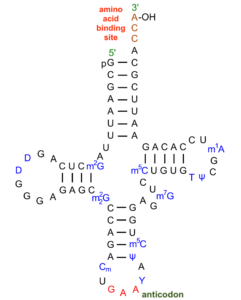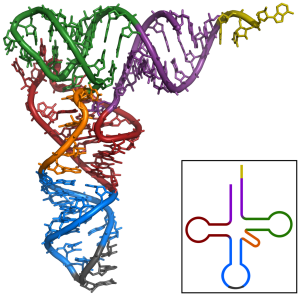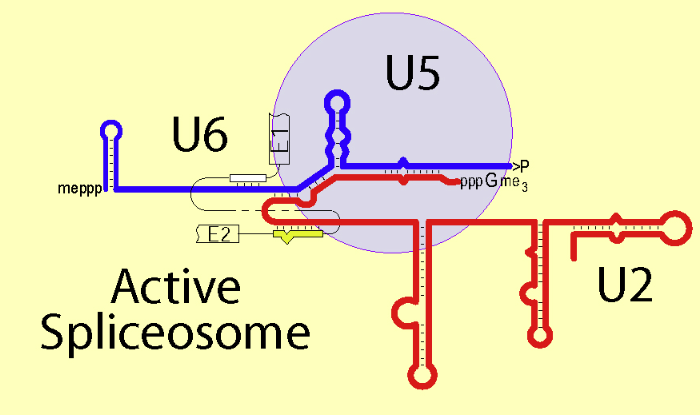1. Introduction
Much of our focus in this module has been on explaining the events and processes described in the table below.
| FIRST | Abiotic creation of monomers (the molecular building blocks of life) | |||
| NEXT | Abiotically link monomers to form polymers | Origin of metabolism. Create a system for processing matter and energy and for removing wastes. | Origin of heredity. Provide the system with a way to pass on instructions for maintenance, growth, and reproduction | Encapsulate the system with a membrane to keep it from dissolving away, creating the first primitive cells. |
In what follows, we’ll look at the origins of heredity, metabolism, and membranes. Let’s go.
2. The Origins of Heredity: The RNA World
Reproduction is a fundamental feature of any living system. In cells today (and probably all the way back to LUCA), reproduction is about passing on hereditary instructions encoded in DNA. But while DNA serves all living things as the repository (or library) of genetic information, it’s a poor candidate for having served as the first molecule of heredity.
The problem is that DNA encodes information for producing proteins, but an entire team of proteins is required for the reproduction of DNA. One component couldn’t have arisen without the others already existing, and it seems beyond the realm of possibility that a system of such complexity (see the diagram below) could have spontaneously arisen, with all of its parts, all at once.
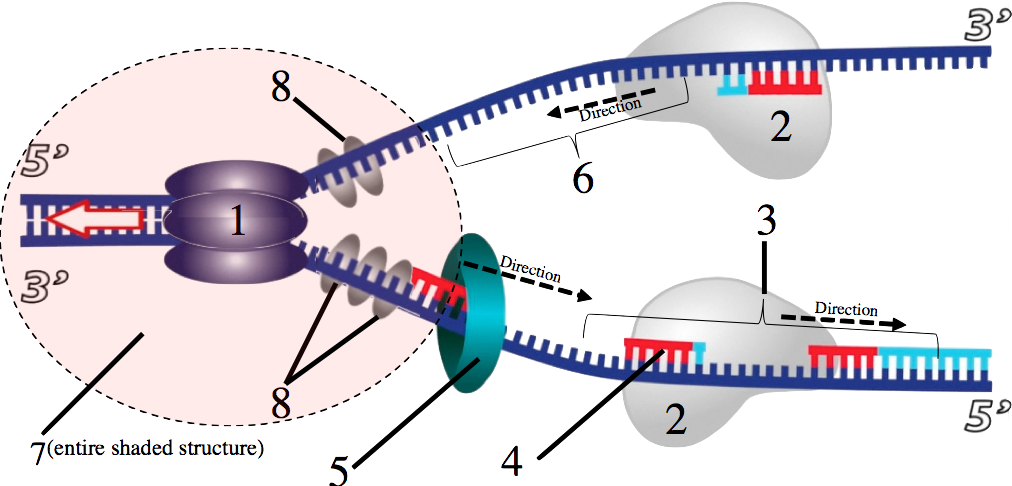
A better alternative for a first hereditary molecule is RNA (ribonucleic acid).
2a.RNA v. DNA
Like DNA, RNA is a polymer composed of nucleotide monomers. But it’s different from DNA in several ways:
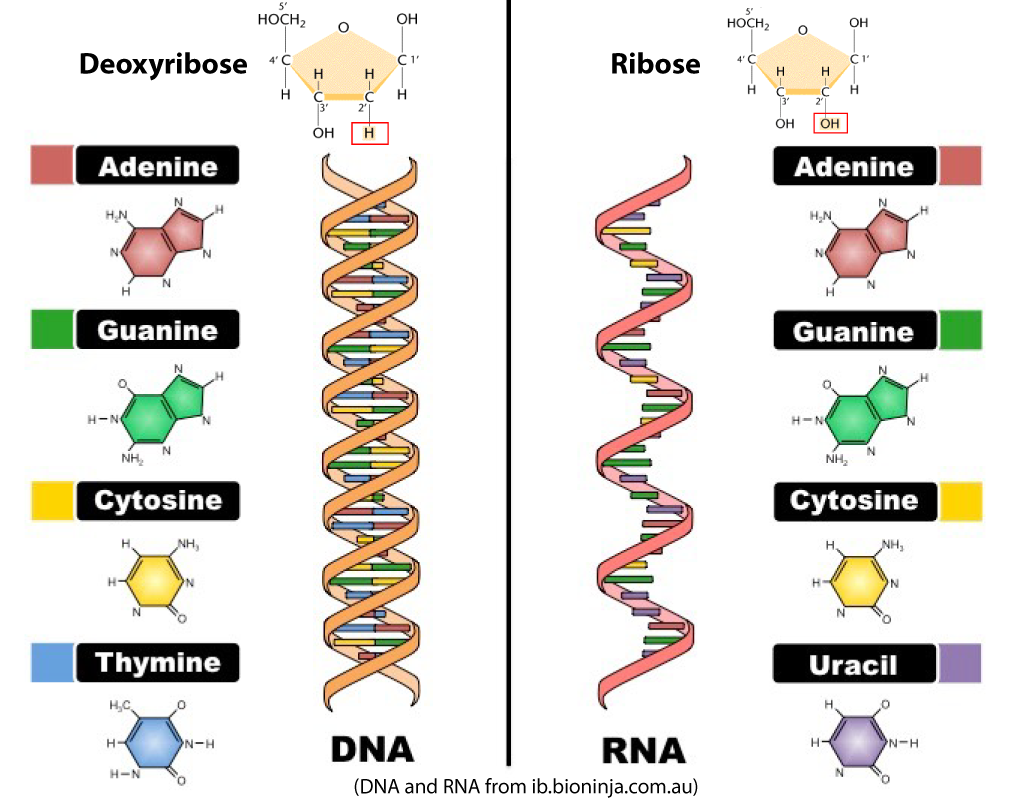
 RNA nucleotides are built around the sugar ribose, while DNA contains deoxyribose. Both are sugars that are built around five carbon atoms, but ribose has a hydroxyl group attached to the 2′ carbon (see the diagram at right and find the 2′ carbon), while deoxyribose has a hydrogen atom (which is why it’s called deoxyribose).
RNA nucleotides are built around the sugar ribose, while DNA contains deoxyribose. Both are sugars that are built around five carbon atoms, but ribose has a hydroxyl group attached to the 2′ carbon (see the diagram at right and find the 2′ carbon), while deoxyribose has a hydrogen atom (which is why it’s called deoxyribose).- While DNA uses the nitrogenous pyrimidine base thymine, RNA uses uracil.
- RNA is single-stranded (unlike DNA, which is double-stranded)
- DNA’s double-stranded nature means that its three-dimensional shape is always a double helix. Because RNA is single-stranded, its conformation is not constrained in the same way. Some RNA, like mRNA (messenger RNA), is a linear strand. But because the nitrogenous bases within a single RNA molecule can bond with one another, an RNA molecule can twist and bend into an unlimited number of shapes. You can see internal hydrogen bonding and the 3-D folding that results in the two representations of a transfer RNA molecule shown below.
|
|
|
2b. Ribozymes are catalytic RNAs that function as enzymes
In RNA viruses and in viroids (parasitic RNAs that infect plants) RNA has an informational role. In these two cases, RNA takes on the function of DNA, and stores genetic information. But as we’ve just seen, RNA’s conformational flexibility lets it do something that DNA can’t: folding into complex shapes. Some of these shapes result in RNAs that perform like enzymes, catalyzing chemical reactions. In other words, RNA can be both genotype and phenotype. This has been known since the 1980s, when catalytic RNAs, or ribozymes, were first discovered.
One function of ribozymes involves processing RNA or DNA through cutting or ligation (connecting pieces of another molecule.). For example, the eukaryotic RNA processing that occurs between the transcription of pre-RNA and the formation of mRNA is carried out by a team of interacting RNA molecules that form a spliceosome. Spliceosomes are ribozymes that take pre-RNA and remove introns, creating messenger RNA.
|
|
|
Ribosomes, which catalyze peptide bonds between adjacent amino acids during protein synthesis, are also ribozymes.
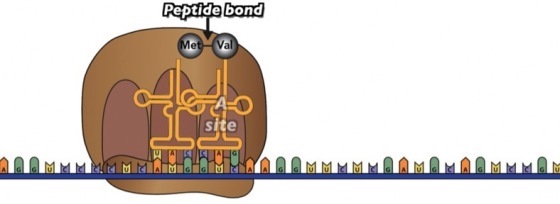
2c. In today’s world RNA doesn’t self-replicate, but let’s imagine how it could
So, we’ve established that RNA can be genotype (information) and phenotype (action, as in ribozymes). The RNA world is a hypothetical stage in the evolution of life where RNA plays both roles, without the support of DNA (for information storage) or protein (for enzymes, structure-building, and just about everything else). But could RNA replicate without protein?
It doesn’t happen in today’s world. But let’s imagine how it could. During DNA replication, the double helix has to be unzipped by the enzyme DNA helicase. Then other enzymes, particularly DNA polymerase, use each of the separated single strands as a template for creating a new complementary strand. This is called “semi-conservative” replication.

There are only a few cases in nature today where RNA is directly replicated into new RNA in a manner analogous to what’s shown above.
- In viroids, infectious, single-stranded circular RNAs that parasitize plants. Viroids don’t code for protein. They reproduce themselves by using RNA polymerase (a protein) from their hosts (the plant cells that they’ve infected).
- In coronaviruses, the viruses’ genomic RNA is replicated through an enzyme called RNA replicase.
Now imagine a molecule of RNA that could both serve as a genetic template, and fold into a shape that would let it catalyze its own replication. If supplied with free nucleotides, that self-replicating viroid would constitute something pretty close to an RNA life form. It would lack a metabolism, but it could self-replicate, and evolve.
2d. The RNA World
That’s essentially what the RNA world is. The RNA world would have consisted of self-replicating, evolving RNAs. This world would have emerged before cells, and before LUCA. It would have consisted of populations of RNAs that would have arisen pre-biotically. Some of these RNAs would be dependent upon one another, while others would be competing with one another (for resources such as access to the monomers required for self-assembly). During the replication process, mutations would arise, leading to a type of natural selection. Those RNA replicators that could replicate more quickly and efficiently would come to dominate their populations, just as natural selection causes beneficial alleles to spread throughout a species.
What’s the evidence for the RNA world? Theodor Diener, the discoverer of viroids, has suggested that viroids are a vestige of the RNA world (click to read Diener’s arguments, and rebuttals). In addition, scientists are working on creating RNA self-replication systems in the laboratory. For example, a ribozyme that is 189 base pairs long has been created that can synthesize complementary RNA from a 14-nucleotide RNA template. Along the same lines, RNA ribozymes have been artificially selected that are capable of copying almost any other RNA…though not itself (see this Wikipedia article).
Watch the video below, which explains and animates these points.
Some of the biology described in this video (the emergence of the RNA world in tidepools, for example) runs counter to points I’ve made in the previous tutorial about the unlikelihood of life emerging in tidepools. But there’s no contradiction between the RNA world and the environments created by alkaline hydrothermal vents. For example, it’s possible that the tiny porous chambers in alkaline hydrothermal vent systems, with their constant flow of hydrogen and production of reduced carbon compounds, might have been the type of environment in which RNA nucleotides could have been synthesized and concentrated. Moreover, the presence of mineral catalysts in these micropores could have promoted the polymerization of RNA nucleotides into RNA polymers. Catalytic properties emerging in evolving RNAs in these systems could have led to the first RNA-protein systems, which in turn, could lead to the emergence of the genetic code. And at some point on the road to LUCA, DNA took over the role of genetic storage from RNA.
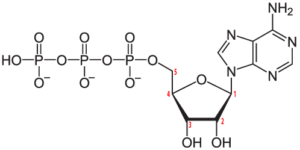
That’s not to say that there wouldn’t be difficulties in bringing this RNA world about. RNA is composed of RNA nucleotides, and these nucleotides are much more complex than the amino acids that Stanley Miller was able to synthesize in his spark chamber experiments. That makes the likelihood of their spontaneous emergence low. And, as the video you just watched acknowledged, polymerization of RNA nucleotides (even under the best laboratory conditions) is difficult. So the challenge for scientists working on the origin of life is finding a pathway from abiotically emerging monomers to self-reproducing RNAs, to LUCA, with every step along the way being gradual enough so as not to appear miraculous. The RNA world might be a step along that path, but many steps are needed to get to the RNA world and to get from the RNA world to the world of cells.
Take the following quiz about the RNA world. Then we’ll look at the formation of cells, and then return to the alkaline hydrothermal vents where life may have first emerged.
3. The RNA World: Checking Understanding
[qwiz random = “false” qrecord_id=”sciencemusicvideosMeister1961-RNA World, Checking Understanding”]
[h]The RNA World
[i]An origin of life haiku
An RNA world
Could these self-replicating
molecules evolve?
[q] DNA can only serve as an organism’s [hangman]. RNA, by contrast, can play DNA’s role, and also serve as [hangman]. Additional hint: think of two rhyming terms associated with genetics.
[c]IGdlbm90eXBl[Qq]
[f]IEdyZWF0IQ==[Qq]
[c]IHBoZW5vdHlwZQ==[Qq]
[f]IEdyZWF0IQ==[Qq]
[q] A conundrum associated with figuring out the origins of heredity is that DNA requires [hangman] to be replicated, but these proteins only exist because they’re coded for by [hangman].
[c]IHByb3RlaW5z[Qq]
[f]IEV4Y2VsbGVudCE=[Qq]
[c]IEROQQ==[Qq]
[f]IEdyZWF0IQ==[Qq]
[q] Whereas the sugar in DNA is [hangman], the sugar in RNA is[hangman].
[c]IGRlb3h5cmlib3Nl[Qq]
[f]IEdyZWF0IQ==[Qq]
[c]IHJpYm9zZQ==[Qq]
[f]IENvcnJlY3Qh[Qq]
[q] Which of the nucleotides below is found in DNA?
[textentry single_char=”true”]
[c]IE I=[Qq]
[f]IEV4Y2VsbGVudCEgJiM4MjIwO0ImIzgyMjE7IGlzIGEgZGVveHlyaWJvbnVjbGVvdGlkZS4gSXQgY29udGFpbnMgZGVveHlyaWJvc2UsIHRoZSBzdWdhciBpbiBETkEu[Qq]
[c]IEE=[Qq]
[f]IE5vLiAmIzgyMjA7QSYjODIyMTsgaXMgYSBkaWRlb3h5bnVjbGVvdGlkZS4gSXQmIzgyMTc7cyBiZWVuIGRvdWJseSBkZW94eWdlbmF0ZWQuIEZpbmQgdGhlIG1vbGVjdWxlIHRoYXQmIzgyMTc7cyBhIGRlb3h5bnVjbGVvdGlkZSAoZGVveHlnZW5hdGVkIGluIGNvbXBhcmlzb24gdG8gcmlib3NlKS4=[Qq]
[c]ICo=[Qq]
[f]IE5vLiBETkEmIzgyMTc7cyBuYW1lICgmIzgyMjA7ZGVveHlyaWJvbnVjbGVpYyBhY2lkJiM4MjIxOykgaXMgYSBoaW50LiBGaW5kIGEgbW9sZWN1bGUgd2l0aCBhIHN1Z2FyIHRoYXQsIGNvbXBhcmVkIHRvIHJpYm9zZSwgaGFzIGEgc2luZ2xlIGxvc3Qgb3h5Z2Vu[Qq]
[q] Which of the nucleotides below is found in RNA?
[textentry single_char=”true”]
[c]IE M=[Qq]
[f]IEV4Y2VsbGVudCEgJiM4MjIwO0MmIzgyMjE7IGlzIGEgcmlib251Y2xlb3RpZGUuIEl0IGNvbnRhaW5zIHJpYm9zZSwgdGhlIHN1Z2FyIGluIFJOQS4=[Qq]
[c]IEE=[Qq]
[f]IE5vLiAmIzgyMjA7QSYjODIyMTsgaXMgYSBkaWRlb3h5bnVjbGVvdGlkZS4gSXQmIzgyMTc7cyBiZWVuIGRvdWJseSBkZW94eWdlbmF0ZWQuIEZpbmQgdGhlIG1vbGVjdWxlIHRoYXQmIzgyMTc7cyBhIGRlb3h5bnVjbGVvdGlkZSAoZGVveHlnZW5hdGVkIGluIGNvbXBhcmlzb24gdG8gcmlib3NlKS4=[Qq]
[c]IEI=[Qq]
[f]IE5vLiAmIzgyMjA7QiYjODIyMTsgaXMgYSBkZW94eW51Y2xlb3RpZGUuIEl0IGNvbnRhaW5zIGRlb3h5cmlib3NlLCB0aGUgc3VnYXIgaW4gRE5BLg==[Qq]
[c]ICo=[Qq]
[f]IE5vLCB0aGF0JiM4MjE3O3Mgbm90IGNvcnJlY3Qu[Qq]
[q] Three of the nitrogenous bases in DNA and RNA are the same, but there’s one difference. Whereas DNA uses the base [hangman], RNA uses the base[hangman].
[c]IFRoeW1pbmU=[Qq]
[f]IEdvb2Qh[Qq]
[c]IHVyYWNpbA==[Qq]
[f]IEdyZWF0IQ==[Qq]
[q] In both DNA and RNA, the bonds between complementary nucleotides are [hangman] bonds. But while DNA is always [hangman] stranded, RNA is [hangman] stranded.
[c]IGh5ZHJvZ2Vu[Qq]
[f]IEdyZWF0IQ==[Qq]
[c]IGRvdWJsZQ==[Qq]
[f]IENvcnJlY3Qh[Qq]
[c]IHNpbmdsZQ==[Qq]
[f]IEdvb2Qh[Qq]
[q] A general name for any RNA molecule with catalytic properties is a [hangman].
[c]IHJpYm96eW1l[Qq]
[f]IEdyZWF0IQ==[Qq]
[q] The ribozyme that carries out RNA editing shown in step “F” below is called a [hangman]. Additional hint: the answer is derived from what’s become an obsolete move in editing film (back when it was actual film) or audiotape (back when audio files were stored as tape)
.
[c]IHNwbGljZW9zb21l[Qq]
[f]IEdvb2Qh[Qq]
[q] A ribozyme that you’ve come to know well in your studies of biology (perhaps without knowing that it was a ribozyme) is shown a “2” below. It’s a [hangman].
[c]IHJpYm9zb21l[Qq]
[f]IEV4Y2VsbGVudCE=[Qq]
[q] Infectious, single-stranded particles of RNA that parasitize plants are called [hangman]. Some biologists think that these are vestiges of the RNA [hangman]
[c]IHZpcm9pZHM=[Qq]
[f]IEdyZWF0IQ==[Qq]
[c]IHdvcmxk[Qq]
[f]IEV4Y2VsbGVudCE=[Qq]
[q] If the RNA world ever existed, it would have been before [hangman], the organism that’s at the base of the tree of life.
[c]IExVQ0E=[Qq]
[f]IENvcnJlY3Qh[Qq]
[q] For RNAs in the RNA world to be able to evolve, reproduction would have to be accompanied by [hangman], creating the variation that makes natural [hangman]possible.
[c]IG11dGF0aW9u[Qq]
[f]IENvcnJlY3Qh[Qq]
[c]IHNlbGVjdGlvbg==[Qq]
[f]IENvcnJlY3Qh[Qq]
[q] In the diagram below, which letter would represent abiotically formed RNA nucleotides?
[textentry single_char=”true”]
[c]IG E=[Qq]
[f]IEV4Y2VsbGVudC4gVGhlIGxldHRlciAmIzgyMjA7YSYjODIyMTsgcmVwcmVzZW50cyBhYmlvdGljYWxseSBmb3JtZWQgUk5BIG51Y2xlb3RpZGVzLg==[Qq]
[c]IEVudGVyIHdvcmQ=[Qq]
[f]IE5vLg==[Qq]
[c]ICo=[Qq]
[f]IE5vLiBMb29rIGZvciBhIG1vbm9tZXIgdGhhdCBjb3VsZCBzZXJ2ZSB0byBidWlsZCB1cCB0aGUgUk5BIChhIHBvbHltZXIpIHRoYXQgaXMgdGhlIHN0YXIgcGxheWVyIGluIHRoaXMgZGlhZ3JhbS4=[Qq]
[q] In the diagram below, which letter would represent the formation of randomly sequenced RNA molecules that have emerged through the formation of sugar-phosphate bonds between free RNA nucleotides?
[textentry single_char=”true”]
[c]IG I=[Qq]
[f]IEV4Y2VsbGVudC4gTGV0dGVyICYjODIyMDtiJiM4MjIxOyByZXByZXNlbnRzIGFiaW90aWNhbGx5IGZvcm1lZCBSTkEuIFRoZXJlIHdhcyBubyB0ZW1wbGF0ZSBkZXRlcm1pbmluZyB0aGUgc2VxdWVuY2Ugb2YgdGhlIFJOQSBudWNsZW90aWRlcywgc28gdGhhdCBzZXF1ZW5jZSBjYW4gYmUgdGhvdWdodCBvZiBhcyByYW5kb20u[Qq]
[c]IEVudGVyIHdvcmQ=[Qq]
[f]IFNvcnJ5LCB0aGF0JiM4MjE3O3Mgbm90IGNvcnJlY3Qu[Qq]
[c]ICo=[Qq]
[f]IE5vLiBMb29rIGZvciBSTkEgbW9sZWN1bGVzIHRoYXQgc2VlbSB0byBoYXZlIGZvcm1lZCB3aXRob3V0IGEgdGVtcGxhdGUu[Qq]
[q] In the diagram below, which letter represents template-driven RNA synthesis?
[textentry single_char=”true”]
[c]IG M=[Qq]
[f]IE5pY2UuIExldHRlciAmIzgyMjA7YyYjODIyMTsgcmVwcmVzZW50cyBSTkEgbW9sZWN1bGVzIHRoYXQgYXJlIGJlaW5nIHJlcGxpY2F0ZWQgYmFzZWQgb24gYSBwcmVleGlzdGluZyB0ZW1wbGF0ZS4=[Qq]
[c]IEVudGVyIHdvcmQ=[Qq]
[f]IFNvcnJ5LCB0aGF0JiM4MjE3O3Mgbm90IGNvcnJlY3Qu[Qq]
[c]ICo=[Qq]
[f]IE5vLiBMb29rIGZvciBSTkEgbW9sZWN1bGVzIHRoYXQgc2VlbSB0byBiZSBmb3JtaW5nIGZyb20gb3RoZXIgUk5BIG1vbGVjdWxlcy4=[Qq]
[q] If the letter “e” represents an amino acid, then which letter below represents the first protein that would have emerged?
[textentry single_char=”true”]
[c]IG Y=[Qq]
[f]IE5pY2UuIFRoZSBsZXR0ZXIgJiM4MjIwO2YmIzgyMjE7IHJlcHJlc2VudHMgYW1pbm8gYWNpZHMgdGhhdCBoYXZlLCB0aHJvdWdoIHRoZSBhY3Rpb24gb2YgUk5BLCBiZWVuIHBvbHltZXJpemVkIGludG8gYSBwcm90ZWluLg==[Qq]
[c]IEVudGVyIHdvcmQ=[Qq]
[f]IFNvcnJ5LCB0aGF0JiM4MjE3O3Mgbm90IGNvcnJlY3Qu[Qq]
[c]ICo=[Qq]
[f]IE5vLiBMb29rIGZvciBhIG1vbGVjdWxlIHRoYXQgd291bGQgYmUgYSBwb2x5bWVyIG9mIGFuIGFtaW5vIGFjaWQgKHNob3duIGF0ICYjODIyMDtlJiM4MjIxOyku[Qq]
[q] At some point in the early evolution of life, RNA would have started coding for protein, a process known as translation. In the scenario proposed below, translation would have emerged before DNA, RNA, and protein became encapsulated into cells. Which letter shows translation first emerging?
[textentry single_char=”true”]
[c]IG k=[Qq]
[f]IE5pY2UuIFRoZSBsZXR0ZXIgJiM4MjIwO2kmIzgyMjE7IHJlcHJlc2VudHMgdHJhbnNsYXRpb24gaW4gYSBjZWxsLWZyZWUgc3lzdGVtLg==[Qq]
[c]IG0=[Qq]
[f]IE5vIHF1aXRlLiBUaGUgbGV0dGVyICYjODIyMDttJiM4MjIxOyBpcyB0cmFuc2xhdGlvbiwgYnV0IGl0JiM4MjE3O3MgaW5zaWRlIGEgY2VsbC7CoA==[Qq]
[c]ICo=[Qq]
[f]IE5vLiBMb29rIGZvciBhbiBhcnJvdyB0aGF0IHJlcHJlc2VudHMgUk5BIHRoYXQmIzgyMTc7cyBiZWluZyB0cmFuc2xhdGVkIGludG8gcHJvdGVpbiwgYnV0IG91dHNpZGUgb2YgYSBjZWxsLg==[Qq]
[q] At some point in the evolution of life, DNA would have taken over from RNA as the molecule of heredity. In some viruses, genetic RNA is converted into DNA through a process called reverse transcription. Which arrow represents that process?
[textentry single_char=”true”]
[c]IG g=[Qq]
[f]IE5pY2UuIFRoZSBsZXR0ZXIgJiM4MjIwO2gmIzgyMjE7IHJlcHJlc2VudHMgcmV2ZXJzZSB0cmFuc2NyaXB0aW9uIG9mIEROQSBmcm9tIFJOQS4=[Qq]
[c]IEVudGVyIHdvcmQ=[Qq]
[f]IFNvcnJ5LCB0aGF0JiM4MjE3O3Mgbm90IGNvcnJlY3Qu[Qq]
[c]ICo=[Qq]
[f]IE5vLiBMb29rIGZvciBhIEROQSB0aGF0JiM4MjE3O3MgYmVpbmcgY3JlYXRlZCBiYXNlZCBvbiBpbmZvcm1hdGlvbiBmbG93aW5nIHRvIGl0IGZyb20gUk5BLiBUaGF0JiM4MjE3O3MgcmV2ZXJzZSB0cmFuc2NyaXB0aW9uLg==[Qq]
[q] Once DNA emerged as the molecule of heredity, the process of DNA being transcribed into RNA would become a key process in the life of every cell. Which letter represents transcription?
[textentry single_char=”true”]
[c]IG w=[Qq]
[f]IE5pY2UuIFRoZSBsZXR0ZXIgJiM4MjIwO2wmIzgyMjE7IHJlcHJlc2VudHMgdGhlIHRyYW5zY3JpcHRpb24gb2YgUk5BIGZyb20gRE5BLg==[Qq]
[c]IGg=[Qq]
[f]wqA=Tm8uIFRoZSBsZXR0ZXIgJiM4MjIwO2gmIzgyMjE7IHJlcHJlc2VudHMgcmV2ZXJzZSB0cmFuc2NyaXB0aW9uLCBub3QgdHJhbnNjcmlwdGlvbi4=[Qq]
[c]ICo=[Qq]
[f]IE5vLiBMb29rIGZvciBhbiBhcnJvdyB0aGF0IGluZGljYXRlcyB0aGF0IGluZm9ybWF0aW9uIGZyb20gRE5BIGlzIGZsb3dpbmcgdG8gUk5BLg==[Qq]
[x]
[restart]
[/qwiz]
4. Encapsulation: Forming Membranes and the First Cells
To encapsulate means “to enclose within.” Of all the steps leading up to the origin of the first cells, the step of encapsulating an emerging living system within a membrane seems to be one of the most straightforward. The following video from Stated Clearly does a great job explaining how abiotically generated fatty acids could self-organize to form micelles and then liposomes: fluid-filled spheres surrounded by a lipid bilayer.
A key point that I hope you noted was that heredity, metabolism, and membranes could have all arisen at the same time, with advances in each feature promoting advances in other features.
In the quiz that follows, I threw in some concepts relating to membrane structure, which you probably learned earlier in your biology course. If you want to review, here’s a link to my tutorial about phospholipids and membrane structure (which has everything you need to know for the quiz)
5. Encapsulation, Forming Membranes Quiz
[qwiz random = “true” qrecord_id=”sciencemusicvideosMeister1961-Encapsulation, Forming Membranes”] [h]
Encapsulation: The Origin of Membranes
[i]
[q] The diagram below shows three representations of fatty acids. The part that is attracted to water is at number
[textentry single_char=”true”]
[c]ID I=[Qq]
[f]IFllcy4gUmVnaW9uIDIgaXMgYSBjYXJib3h5bGljIGFjaWQgZnVuY3Rpb25hbCBncm91cCwgYW5kIGl0IGhhcyBwb2xhciBhbmQgaHlkcm9waGlsaWMgcHJvcGVydGllcyB0aGF0IGNhdXNlIGl0IHRvIGJlIGF0dHJhY3RlZCB0byB3YXRlci4=[Qq]
[c]IEVudGVyIHdvcmQ=[Qq]
[f]IFNvcnJ5LCB0aGF0JiM4MjE3O3Mgbm90IGNvcnJlY3Qu[Qq]
[c]ICo=[Qq]
[f]IE5vLiBSZWdpb24gJiM4MjIwOzEmIzgyMjE7IGlzIGEgYmlnIGh5ZHJvY2FyYm9uIGNoYWluLiBUaGlzIHBhcnQgb2YgdGhlIG1vbGVjdWxlIHdvdWxkIGJlIGh5ZHJvcGhvYmljIChyZXBlbGxlZCBieSB3YXRlciku[Qq]
[q] The molecule shown below (in three different representations) is a(n) [hangman] acid.
[c]ZmF0dHk=[Qq]
[f]IEdyZWF0IQ==[Qq]
[q] To answer the question below, think about what you’ve already learned about cell membranes and lipid bilayers. In terms of interactions with water, part 2 of the molecule below can be described as[hangman].
[c]IGh5ZHJvcGhpbGlj[Qq]
[f]IEdyZWF0IQ==[Qq]
[q]To answer the question below, think about what you’ve already learned about cell membranes and lipid bilayers. In terms of interactions with water, part 1 of the molecule below can be described as [hangman].
[c]IGh5ZHJvcGhvYmlj[Qq]
[f]IEdyZWF0IQ==[Qq]
[q] According to the video, fatty acids can form [hangman] in environments that have mineral [hangman], and raw materials such as [hangman] monoxide and hydrogen.
[c]IGFiaW90aWNhbGx5[Qq]
[f]IEdyZWF0IQ==[Qq]
[c]IGNhdGFseXN0cw==[Qq]
[f]IEdyZWF0IQ==[Qq]
[c]IGNhcmJvbg==[Qq]
[f]IEdvb2Qh[Qq]
[q multiple_choice=”true”] The structure shown below is a
[c]IGNlbGw=[Qq]
[f]IE5vLiBUaGlzIHN0cnVjdHVyZSBzcG9udGFuZW91c2x5IGVtZXJnZXMgd2hlbiBtb2xlY3VsZXMgbGlrZSBmYXR0eSBhY2lkcyBpbnRlcmFjdCB3aXRoIG9uZSBhbm90aGVyIGluIGEgd2F0ZXJ5IGVudmlyb25tZW50Lg==[Qq]
[c]IGxpcGlkIGJpbGF5ZXI=[Qq]
[f]IE5vLiBUbyBiZSBhIGJpbGF5ZXIsIHlvdSBoYXZlIHRvIGhhdmUgVFdPIGxheWVycy4gSGVyZSB0aGVyZSYjODIxNztzIG9ubHkgb25lLg==[Qq]
[c]IA ==bWljZWxsZQ==[Qq]
[f]IE5pY2Ugam9iISBUaGUgc3RydWN0dXJlIHNob3duIGlzIGEgbWljZWxsZS4=[Qq]
[q] The structure shown below contains a lipid [hangman]
[c]IGJpbGF5ZXI=[Qq]
[f]IENvcnJlY3Qh[Qq]
[q] The structure shown below is called a [hangman]
[c]IGxpcG9zb21l[Qq]
[f]IENvcnJlY3Qh[Qq]
[q multiple_choice=”true”] Structures like the one shown below
[c]IHJlc3VsdCBmcm9tIGRlaHlkcmF0aW9uIHN5bnRoZXNpcyByZWFjdGlvbnMu[Qq]
[f]IE5vLiBUaGF0JiM4MjE3O3MgaG93IGVuenltZXMgY29uc3RydWN0IHBvbHltZXJzIGZyb20gbW9ub21lcnMuIFdoYXQmIzgyMTc7cyBoYXBwZW5pbmcgaGVyZSByZXN1bHRzIGZyb20gdGhlIHByb3BlcnRpZXMgb2YgdGhlIG1vbGVjdWxlcyBzaG93biwgdGhlaXIgaW50ZXJhY3Rpb25zIHdpdGggZWFjaCBvdGhlciwgYW5kIHRoZWlyIGludGVyYWN0aW9ucyB3aXRoIHdhdGVyLg==[Qq]
[c]IHJlc3VsdCBmcm9tIGVuenltZXMgdGhhdCBldm9sdmVkIHRvIHBsYWNlIGVhY2ggbW9sZWN1bGUgaW4gYSBzcGVjaWZpYyBwb3NpdGlvbi4=[Qq]
[f]IE5vLiBXaGF0JiM4MjE3O3MgaGFwcGVuaW5nIGhlcmUgcmVzdWx0cyBmcm9tIHRoZSBwcm9wZXJ0aWVzIG9mIHRoZSBtb2xlY3VsZXMgc2hvd24sIHRoZWlyIGludGVyYWN0aW9ucyB3aXRoIGVhY2ggb3RoZXIsIGFuZCB0aGVpciBpbnRlcmFjdGlvbnMgd2l0aCB3YXRlci4=[Qq]
[c]IHJlc3VsdCBhcyBhbiBlbWVyZ2VudCBwcm9wZXJ0eSBvZiB0aGUgbW9sZWN1bGVzIHRoZXkmIzgyMTc7cmUgbWFkZSBvZiwg dGhlIHdheSB0aGV5IGludGVyYWN0IHdpdGggZWFjaCBvdGhlciwgYW5kIGhvdyB0aGV5IGludGVyYWN0IHdpdGggd2F0ZXIu[Qq]
[f]IE5pY2Ugam9iISBUaGF0JiM4MjE3O3MgaG93IHN0cnVjdHVyZXMgbGlrZSB0aGUgb25lIHNob3duIGVtZXJnZS4=[Qq]
[q multiple_choice=”true”] The video describes a sequence in which the first membrane-like structures emerge. Which of the following best summarizes this process?
[c]IG1pY2VsbGVzIGRpc2FnZ3JlZ2F0ZSBpbnRvIGJpbGF5ZXJlZCBjZWxsLWxpa2Ugc3RydWN0dXJlcywgZWFjaCBvZiB3aGljaCBoYXMgYW4gb3V0ZXIgbWVtYnJhbmUgd2l0aCBhIGJpbGF5ZXJlZCBzdHJ1Y3R1cmU=[Qq]
[f]IE5vLiBXaGlsZSB0aGUgbWljZWxsZXMgY2FuIGZvcm0gaW50byBiaWxheWVyZWQgbWVtYnJhbmVzLCB0aGV5IGRvbiYjODIxNzt0IGRvIHNvIHRocm91Z2ggJiM4MjIwO2Rpc2FnZ3JlZ2F0aW9uLCYjODIyMTsgd2hpY2ggd291bGQgaGF2ZSB0aGUgb3Bwb3NpdGUgZWZmZWN0Lg==[Qq]
[c]IGZhdHR5IGFjaWRzIGZvcm0gbWljZWxsZXMsIHdoaWNoIGFnZ3JlZ2F0ZSB0byBmb3JtIGxpcGlkIHNraW5zLCB3aGljaCBmb2xk IGluIHVwb24gdGhlbXNlbHZlcyB0byBmb3JtIGZsdWlkLWZpbGxlZCBzcGhlcmVzIHdpdGggYmlsYXllcmVkIG1lbWJyYW5lcy4=[Qq]
[f]IEV4YWN0bHkuIFRoZSBrZXkgcG9pbnQgbyB0aGUgdmlkZW8gaXMgYSBzZXF1ZW5jZSB3aGVyZSBmYXR0eSBhY2lkcyBpbnRlcmFjdCB0byBmb3JtIG1pY2VsbGVzLCB3aGljaCBpbnRlcmFjdCB0byBmb3JtIGxpcGlkICYjODIyMDtza2lucywmIzgyMjE7IHdoaWNoIGNhbiBmb2xkIGluIHVwb24gdGhlbXNlbHZlcyB0byBmb3JtIGZsdWlkLWZpbGxlZCBzcGhlcmVzIHdpdGggYmlsYXllciBleHRlcmlvcnMu[Qq]
[c]IGJpbGF5ZXJlZCBwcm90b2NlbGxzIGZpcnN0IGZvcm0gYXMgb3RoZXIgcHJvdG9jZWxscyB3aXRoIGJpbGF5ZXJlZCBtZW1icmFuZXMgc3RyZXRjaCB1bnRpbCB0aGVpciBtZW1icmFuZXMgdG91Y2gsIGdpdmluZyByaXNlIHRvIG5ldyBwcm90b2NlbGxzLCBhbmQga2lja3N0YXJ0aW5nIGV2b2x1dGlvbi4=[Qq]
[f]IE5vLiBPbmNlIHN1Y2ggYSBzeXN0ZW0gaGFzIHN0YXJ0ZWQsIGl0IGNvdWxkIGtlZXAgZ29pbmcgdGhyb3VnaCBhIG1lY2hhbmlzbSBsaWtlIHRoZSBvbmUgZGVzY3JpYmVkIGFib3ZlLiBCdXQgaG93IGRpZCB0aGUgZmlyc3QgcHJvdG9jZWxscyBlbWVyZ2U/[Qq]
[c]IGZhdHR5IGFjaWRzIHNwb250YW5lb3VzbHkgZW1lcmdlIGFzIG1pY2VsbGVzIGZyb20gdGhlIHByaW1vcmRpYWwgc291cC4gVGhlc2UgbWljZWxsZXMgZXZvbHZlIGludG8gdGhlIGZpcnN0IGNlbGxzLCBraWNrc3RhcnRpbmcgZXZvbHV0aW9uLg==[Qq]
[f]IE5vLiBUaGF0IHNvdW5kcyBsaWtlIHRoZSBraW5kIG9mIG1pcmFjdWxvdXMgZXhwbGFuYXRpb24gdGhhdCB3ZSYjODIxNzt2ZSBiZWVuIHRyeWluZyB0byBhdm9pZC4=[Qq]
[q] The diagram below shows a molecule called a [hangman]. This molecule is composed of two [hangman] acids connected to glycerol and a phosphate. At some point in the course of evolution, the molecule below became the key component of [hangman] in all organisms in domains eukarya and bacteria.
[c]cGhvc3Bob2xpcGlk
[c]ZmF0dHk=[Qq]
[c]bWVtYnJhbmVz[Qq]
[x][restart]
[/qwiz]
5. Origins of Life’s Chemiosmotic Metabolism
Life on Earth is based on protons flowing across membranes. If you’ve studied cellular respiration, then you know that almost all the ATP created in cellular respiration is made as protons diffuse across the ATP synthase channel of the mitochondrial inner membrane. In photosynthesis, during the light reactions, there’s a parallel flow of protons across the thylakoid membrane, through ATP synthase, and this flow creates ATP that provides the energy that makes the reduction of carbon dioxide to carbohydrates possible.
Proton flow, is in turn, based upon electron flow. Photosynthesizers (mostly plants and cyanobacteria) convert light energy into a flow of electrons. The energy from that flow is used to pump protons into the thylakoid spaces in thylakoid sacs. Then the protons diffuse out through ATP synthase, generating ATP. In mitochondria, a flow of electrons from food molecules is used to pump protons into the mitochondrial intermembrane space. Then, just in photosynthesis, the protons flow out through ATP synthase, generating ATP.
So, assuming that life emerged not at the Earth’s sunlight surface, but deep in the ocean depths, how could ATP-creating proton gradients have evolved? Let’s review what’s happening in these vents about 3.8 bya. Because of serpentinization at alkaline hydrothermal vents, hydrogen gas was bubbling into carbon dioxide-rich seawater. With the help of iron-sulfur catalysts, the hydrogen and carbon dioxide combined into methane. Further catalytic action created monomers, which then became concentrated in the tiny, cell-sized pores within the vents. This concentration of monomers made it easier for inorganic catalysts to combine these monomers into polymers.
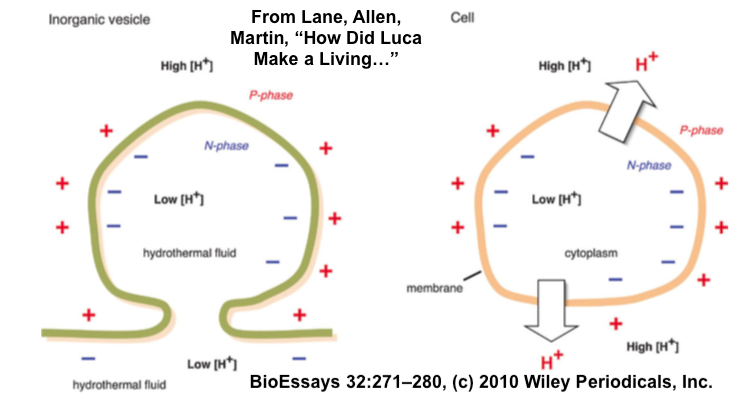
The image above shows one of these tiny pores, with a cell shown on the right for comparison. Alkaline fluids, created during the process of serpentinization in the rocks below the vents (notice the “Low [H]” label below the green inorganic vesicle on the left) would have flowed into these pores. This would have created a natural proton gradient between the acidic seawater outside the vents and the alkaline fluid inside the vents. That proton gradient is parallel to the one that cells today have to create by electron flows powered by food or sunlight. But in the vents, the gradient was there for free. Protons would flow “downhill” from outside the rocky vesicles to the inside. This flow, if captured, could power the creation of phosphorylated compounds, forerunners of ATP. These compounds, in turn, could provide the chemical energy to power the creation of RNA polymers, leading to the RNA world…
Here’s a quote from biochemist Nick Lane, author of Life Ascending, one of my favorite biology books.
The last common ancestor of all life was not a free-living cell at all, but a porous rock riddled with bubbly iron-sulfur membranes that catalyzed primordial biochemical reactions. Powered by hydrogen and proton gradients, this natural flow reactor filled up with organic chemicals, giving rise to proto-life that eventually broke out as the first living cells – not once but twice, giving rise to the bacteria and the archaea. (Nick Lane, The Cradle of Life: New Scientist, 17, October 2009).
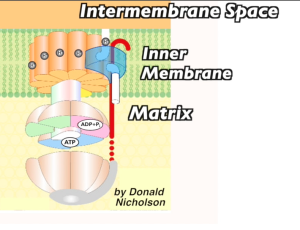 There are some big gaps in this account. One gap is the emergence of ATP synthase, a complex molecular machine with a spinning rotor and multiple interdependent parts. Origin of life researchers will have to continue their work to create a credible account of how this machine (shown at left in its mitochondrial form) could have arisen in a step-by-step manner (that doesn’t seem miraculous).
There are some big gaps in this account. One gap is the emergence of ATP synthase, a complex molecular machine with a spinning rotor and multiple interdependent parts. Origin of life researchers will have to continue their work to create a credible account of how this machine (shown at left in its mitochondrial form) could have arisen in a step-by-step manner (that doesn’t seem miraculous).
6. Returning to Undersea Alkaline Hydrothermal Vents: A second viewing of the Origin of Life Video (the whole thing)
Let’s return to the vents. Please watch the entire video by William Martin and Mike Russell that explains the emergence of life at alkaline hydrothermal vents. If you feel like it’s too much review (and you remember the first three minutes), then you can manually jump to 3:10.
Unfortunately, the idea of chemiosmosis at the vents isn’t portrayed or mentioned, even though it’s an essential part of the story. If you want to take a deeper dive into this material, you can read articles by Russell, Martin, and some of their collaborators (including Deborah Kelley, who discovered alkaline hydrothermal vents in 2000), at this link. A much more accessible article written by Nick Lane can be found here.
And that is as far as we’re going to go in this introductory account of life’s emergence. If you’re like me, this module is leaving you with some big questions, which I encourage you to explore. Here are just three options. If you have the time and the inclination, please follow some of the suggested links if you’re interested in seeing how this work is progressing. All links open new tabs (and note that some of this is very dense reading).
- How did the genetic code arise? See articles by Keeling, or Koonin and Novoshilov.
- How did the system of protein translation from mRNA evolve? See articles by Noller, or Petrov et.al.
- How and when did DNA take over from RNA? See Forterre et. al
7. Origins of Life: Cumulative Quiz
Let’s consolidate what we’ve learned with the following quiz. It includes information from the entire module.
[qwiz random = “false” qrecord_id=”sciencemusicvideosMeister1961-Origin of Life, Cumulative Quiz”]
[h]Origin of Life: Cumulative Quiz
[i]
[q labels = “top”]Describe the traits of LUCA.
- _________ celled ___________
- Genetic information was encoded in _____.
- Genes were transcribed into ______, which was translated into ________ composed of 20 ____________.
- Used the universal genetic code, with 64 __________.
- Translation was catalyzed by__________.
- Metabolism created _________ to power cellular work.
- The entire cell was surrounded by a lipid ___________.
- Created ATP by _____________.
[l]amino acids
[f*] Correct!
[fx] No. Please try again.
[l]ATP
[f*] Excellent!
[fx] No, that’s not correct. Please try again.
[l]chemiosmosis
[f*] Great!
[fx] No, that’s not correct. Please try again.
[l]codons
[f*] Excellent!
[fx] No. Please try again.
[l]DNA
[f*] Excellent!
[fx] No. Please try again.
[l]membrane
[f*] Excellent!
[fx] No, that’s not correct. Please try again.
[l]prokaryote
[f*] Correct!
[fx] No. Please try again.
[l]proteins
[f*] Excellent!
[fx] No, that’s not correct. Please try again.
[l]ribosomes
[f*] Good!
[fx] No, that’s not correct. Please try again.
[l]RNA
[f*] Great!
[fx] No. Please try again.
[l]Single
[f*] Good!
[fx] No. Please try again.
[q] Despite what’s commonly taught about the universality of this type of molecule for making up the lipid bilayer of membranes, LUCA’s membrane was probably NOT composed of [hangman]. That’s because organisms in one of the three domains of life, the [hangman], build their membranes out of different lipids. The diagram below might help you figure this out.
[c]IHBob3NwaG9saXBpZHM=[Qq]
[c]YXJjaGFlYQ==
[f]IENvcnJlY3Qh[Qq]
[q multiple_choice=”true”] Which of the following dates is most likely for the origin of life?
[c]IDQuNiBieWE=[Qq]
[f]IE5vLiBUaGF0JiM4MjE3O3Mgd2F5IHRvbyBlYXJseS4gVGhhdCYjODIxNztzIHdoZW4gdGhlIEVhcnRoIHdhcyBmaXJzdCBmb3JtaW5nLg==[Qq]
[c]IDQuMSBieWE=[Qq]
[f]IE5vLiBUaGF0JiM4MjE3O3MgZHVyaW5nIHRoZSBwZXJpb2Qgb2YgaGVhdnkgYm9tYmFyZG1lbnQuIEFueSBlbWVyZ2luZyBsaWZlIHByb2JhYmx5IHdvdWxkIGhhdmUgYmVlbiBkZXN0cm95ZWQgYnkgaW5jb21pbmcgbWV0ZW9ycyBhbmQgY29tZXRzLg==[Qq]
[c]IDMuOC BieWE=[Qq]
[f]IEV4Y2VsbGVudCEgWW91JiM4MjE3O3ZlIGNob3NlbiBhIGRhdGUgdGhhdCYjODIxNztzIGJldHdlZW4gdGhlIGVuZCBvZiB0aGUgcGVyaW9kIG9mIGhlYXZ5IGJvbWJhcmRtZW50LCBhbmQgYmVmb3JlIHRoZSBkYXRlIGZvciB0aGUgZWFybGllc3QgZm9zc2lsaXplZCBsaWZlLiBMaWZlIGhhZCB0byBlbWVyZ2Ugc29tZXdoZXJlIGluIGJldHdlZW4u[Qq]
[c]IDMuNSBieWE=[Qq]
[f]IE5vLiBBcyBzaG93biBieSBmb3NzaWxpemVkIHN0cm9tYXRvbGl0ZXMgYW5kIGFzc29jaWF0ZWQgbWljcm9mb3NzaWxzIGZyb20gdGhhdCBwZXJpb2QsIGxpZmUgd2FzIGFscmVhZHkgd2VsbCBlc3RhYmxpc2hlZCBieSAzLjUgYnlhLiBDaG9vc2UgYW4gZWFybGllciBwZXJpb2Qu[Qq]
[q] Dating of ancient structures like fossilized stromatolites is done through a method that involves measuring the decay of radioactive [hangman] of certain elements, a method known as [hangman] dating.
[c]IGlzb3RvcGVz[Qq]
[c]IHJhZGlvbWV0cmlj[Qq]
[q] Stanley Miller’s experiments were significant because he successfully synthesized [hangman] acids in a simulation of the Earth’s early atmosphere.
[c]IGFtaW5v[Qq]
[q] During the Hadean/Archaean periods when life was first emerging, the Earth was very different from today’s Earth. The sun was [hangman]; the [hangman] was closer, causing enormous [hangman]. The atmosphere lacked the gas [hangman]. The Earth was in a period of heavy bombardment and suffered frequent impacts from [hangman] and comets.
[c]IGRpbW1lcg==
[c]IG1vb24=[Qq]
[c]IHRpZGVz[Qq]
[c]IG94eWdlbg==[Qq]
[c]IG1ldGVvcnM=[Qq]
[q]Alkaline [hangman] vents, which release[hangman]gas into the environment, might have provided an environment conducive to the evolution of life.
[c]IGh5ZHJvdGhlcm1hbA==
[c]IGh5ZHJvZ2Vu[Qq]
[q]Darwin speculated that life arose in a warm little [hangman]. That’s unlikely for several reasons, one of which being that the Earth was covered by a huge [hangman], leaving very little land. In addition, constant bombardment by comets and [hangman] would have created a very hostile environment on Earth’s surface.
[c]IFBvbmQ=[Qq]
[c]IG9jZWFu[Qq]
[c]bWV0ZW9ycw==[Qq]
[q]Black smoker vents are unlikely candidates for life’s emergence because the water that’s emerging from them is extremely [hangman].
[c]IGhvdA==[Qq]
[q]At alkaline hydrothermal vents, a process called serpentinization results in the formation of vent fluids that are, in terms of pH, [hangman]. The same process causes the emergence of [hangman] gas. When this gas is combined with carbon dioxide, it could have formed the simple hydrocarbon [hangman], which is a highly reduced compound that could serve as a source of matter and energy for building the first [hangman], the building blocks of polymers.
[c]IGJhc2lj[Qq]
[c]IGh5ZHJvZ2Vu[Qq]
[c]bWV0aGFuZQ==[Qq]
[c]bW9ub21lcnM=
[q]The first membrane-bound cells might have formed as an accumulation of [hangman] acids led to the formation of micelles. These micelles would aggregate together, forming fluid-filled spheres, the outer “skin” of which was a lipid [hangman].
[c]ZmF0dHk=[Qq]
[c]YmlsYXllcg==
[q]It’s possible that LUCA was not a membrane-bound cell, but rather a population of vesicles in a porous [hangman], surviving off of flows of [hangman ] gas, and using the proton-powered flow called [hangman] to power its metabolism.
[c]cm9jaw==[Qq]
[c]aHlkcm9nZW4=[Qq]
[c]Y2hlbWlvc21vc2lz[Qq]
[q] If “c” in the diagram below represents RNA, then ribonucleotides would be represented by
[textentry single_char=”true”]
[c]Qg ==[Qq]
[f]IE5pY2UuIExldHRlciAmIzgyMjA7YiYjODIyMTsgcmVwcmVzZW50cyB0aGUgbW9ub21lcnMgdGhhdCBtYWtlIHVwIFJOQSwgd2hpY2ggYXJlIHJpYm9udWNsZW90aWRlcy4=[Qq]
[c]IHdvcmQ=[Qq]
[f]wqA=Tm8u[Qq]
[c]ICo=[Qq]
[f]IE5vLiBMb29rIGZvciBtb25vbWVycyB0aGF0LCBpZiBzdHJ1bmcgdG9nZXRoZXIsIGNvdWxkIGNyZWF0ZSBhbiBSTkEgcG9seW1lciAoYXQgJiM4MjIwO0MmIzgyMjE7KS4=[Qq]
[q] In the diagram below, the only letter that could possibly represent a ribozyme would be
[textentry single_char=”true”]
[c]RA ==[Qq]
[f]IE5pY2UuIExldHRlciAmIzgyMjA7ZCYjODIyMTsgc2hvd3MgUk5BIHRoYXQmIzgyMTc7cyBmb2xkZWQgaW50byBhIG1vcmUgY29tcGxleCAzLUQgc2hhcGUsIGFuZCB0aGF0JiM4MjE3O3MgaG93IGEgcmlib3p5bWUgd291bGQgZm9ybSAodGhvdWdoIGluIHRoaXMgcmVwcmVzZW50YXRpb24sIHRoZSBzaGFwZSBpcyB2ZXJ5IHNpbXBsZSku[Qq]
[c]IHdvcmQ=[Qq]
[f]wqA=Tm8u[Qq]
[c]ICo=[Qq]
[f]IE5vLiBMb29rIGZvciBhbiBSTkEgcG9seW1lciB0aGF0JiM4MjE3O3MgZm9sZGluZyBpbnRvIGEgbW9yZSBjb21wbGV4IHNoYXBlLg==[Qq]
[q] In the diagram below, if “b” represented a ribonucleotide, then what letter could represent ribose?
[textentry single_char=”true”]
[c]YQ ==[Qq]
[f]IE5pY2UuIExldHRlciAmIzgyMjA7YSYjODIyMTsgc2hvd3Mgc29tZXRoaW5nIHRoYXQgZ29lcyBpbnRvIGFuIFJOQSBudWNsZW90aWRlLCBhbmQgcmlib3NlIGNvdWxkIGJlIHRoYXQgc29tZXRoaW5nLg==[Qq]
[c]IHdvcmQ=[Qq]
[f]wqA=Tm8u[Qq]
[c]ICo=[Qq]
[f]IE5vLiBMb29rIGZvciBzb21ldGhpbmcgdGhhdCB3b3VsZCBiZSBhIGNvbXBvbmVudCBvZiB0aGUgcmlib251Y2xlb3RpZGVzIGluZGljYXRlZCBieSBsZXR0ZXIgJiM4MjIwO2IuJiM4MjIxOw==[Qq]
[q multiple_choice=”true”] In terms of bringing about the RNA world, which of the following steps is the one that has the most experimental evidence?
[c]IEZyb20gQSB0byBC[Qq]
[f]IE5vLiBMZXR0ZXIgJiM4MjIwO2EmIzgyMjE7IHRvIGxldHRlciAmIzgyMjA7YiYjODIyMTsgc2hvd3MgKHZlcnkgc2NoZW1hdGljYWxseSkgdGhlIGNvbXBvbmVudHMgb2YgUk5BIChyaWJvc2UsIG5pdHJvZ2Vub3VzIGJhc2VzLCBhbmQgcGhvc3BoYXRlcykgY29taW5nIHRvZ2V0aGVyIHRvIGZvcm0gYSByaWJvbnVjbGVvdGlkZS4gVGhhdCYjODIxNztzIGJlZW4gZGlmZmljdWx0IHRvIGJyaW5nIGFib3V0IGluIHRoZSBsYWJvcmF0b3J5Lg==[Qq]
[c]IEZyb20gQiB0byBD[Qq]
[f]IE5vLiBGb3JtaW5nIHRoZSAmIzgyMjA7YmFja2JvbmUmIzgyMjE7IG9mIFJOQSBpcyBub3Qgc29tZXRoaW5nIHRoYXQmIzgyMTc7cyBiZWVuIGVhc3kgdG8gYnJpbmcgYWJvdXQgaW4gdGhlIGxhYi4=[Qq]
[c]IEZyb20g QyB0byBE[Qq]
[f]IEV4Y2VsbGVudCEgT25jZSBSTkEgbW9sZWN1bGVzIGhhdmUgZm9ybWVkLCBpdCYjODIxNztzIG5vdCBoYXJkIHRvIGdldCB0aGVtIHRvIGZvbGQgdXAgaW50byBhIHNwZWNpZmljIDMtRCBzaGFwZS4=[Qq]
[q] In the diagram below, lipids would play a key role in which step?
[textentry single_char=”true”]
[c]Zg ==[Qq]
[f]IE5pY2UuIExldHRlciAmIzgyMjA7ZiYjODIyMTsgc2hvd3MgUk5BIGVuY2Fwc3VsYXRlZCB3aXRoaW4gd2hhdCBsb29rcyBsaWtlIGEgY2VsbC4gVGhlIG1lbWJyYW5lIG9mIHRoYXQgY2VsbCB3b3VsZCBiZSBzb21lIGtpbmQgb2YgbGlwaWQu[Qq]
[c]IHdvcmQ=[Qq]
[f]wqA=Tm8u[Qq]
[c]ICo=[Qq]
[f]IE5vLiBSZW1lbWJlciB0aGF0IGEgY2VsbCBtZW1icmFuZSBpcyBjb21wb3NlZCBvZiBhIGxpcGlkIGJpbGF5ZXIuIFdoZXJlIGRvIHlvdSBzZWUgbGlwaWRzPw==[Qq]
[q] Fossilized cells like the ones below are found in remnants of layered bacterial mats called [hangman].
[c]IHN0cm9tYXRvbGl0ZXM=[Qq]
[f]IEdyZWF0IQ==[Qq]
[q] According to NASA, life is a self-______________ chemical system capable of Darwinian evolution.
[hangman]
[c]IHN1c3RhaW5pbmc=[Qq]
[f]IEdyZWF0IQ==[Qq]
[q]Isotope M has a half-life of 5000 years, during which it decays into isotope N. You’re studying a sample of material that has a relative proportion of 25% M and 75% N. How old is this material?
[c]IDUwMDAgeWVhcnMgb2xkLg==[Qq]
[f]IE5vLiA1MDAwIHllYXJzIGlzIG9uZSBoYWxmLWxpZmUsIGR1cmluZyB3aGljaCB0aW1lIHlvdSYjODIxNztkIGV4cGVjdCBoYWxmIG9mIE0gdG8gZGVjYXkgaW50byBOLCBmb3IgYSA1MC81MCByYXRpby4=[Qq]
[c]IDc1MCB5ZWFycy4=[Qq]
[f]IE5vLiBIZXJlJiM4MjE3O3MgaG93IHRvIHRoaW5rIGFib3V0IHRoaXMuIDUwMDAgeWVhcnMgaXMgb25lIGhhbGYtbGlmZSwgZHVyaW5nIHdoaWNoIHRpbWUgeW91JiM4MjE3O2QgZXhwZWN0IGhhbGYgb2YgTSB0byBkZWNheSBpbnRvIE4sIGZvciBhIDUwLzUwIHJhdGlvLiBCYXNlZCBvbiB0aGUgcXVlc3Rpb24sIGZpbmQgdGhlIG51bWJlciBvZiBoYWxmLWxpdmVzLCBhbmQgbXVsdGlwbHkgdGhhdCBieSB0aGUgZHVyYXRpb24gb2YgYSBoYWxmLWxpZmUu[Qq]
[c]IDEwLDAwMCB5 ZWFycyBvbGQ=[Qq]
[f]IEV4Y2VsbGVudC4gSWYgb25seSAyNSUgb2YgdGhlIG9yaWdpbmFsIG1hdGVyaWFsIGlzIGxlZnQsIHRoZW4gdHdvIGhhbGYgbGl2ZXMgaGF2ZSBwYXNzZWQsIGZvciBhIHRvdGFsIG9mIDEwLDAwMCB5ZWFycy4=[Qq]
[x]
[restart]
[/qwiz]
EPILOGUE: Nick Lane’s Ten Steps to the emergence of Life on Earth
Nick Lane is a British biochemist whose work has been referenced several times in this module. He has done an amazing job popularizing the most recent advances related to the origins of life. He’s been enormously influential in shaping my own understanding of living systems, and that, in turn, had deeply influenced my teaching.
Here are his Ten Steps to the Origin of Life (taken verbatim from an article he wrote in NewScientist | 17 October 2009).
If life did evolve in alkaline hydrothermal vents, it might have happened something like this:
1. Water percolated down into newly formed rock under the sea floor, where it reacted with minerals such as olivine, producing a hot alkaline fluid rich in hydrogen, sulfides, and other chemicals. This hot fluid welled up at hydrothermal vents.
2. The early ocean was acidic and rich in dissolved iron. When upwelling hydrothermal fluids reacted with this seawater, they produced carbonate rocks riddled with tiny pores and a “foam” of iron-sulfur bubbles.
3. Inside the bubbles, hydrogen reacted with carbon dioxide to form simple organic molecules such as methane, formate, and acetate. Some of these reactions were catalyzed by the iron-sulfur minerals, which are still found at the heart of many proteins today.
4. The electrochemical gradient between the alkaline vent fluid and the acidic seawater leads to the spontaneous formation of acetyl phosphate and pyrophosphate, which act just like ATP, the chemical that powers living cells. These molecules drove the formation of amino acids and nucleotides, the building blocks of proteins and of RNA and DNA respectively.
5. Thermal currents within the vent pores concentrated large molecules like nucleotides, driving the formation of RNA and DNA – and providing an ideal setting for an RNA world and its evolution into the world of DNA and proteins. Evolution got underway, with sets of molecules capable of producing more of themselves starting to dominate.
6. Fatty molecules coated the iron-sulfur froth and spontaneously formed cell-like bubbles. Some of these bubbles would have enclosed self-replicating sets of molecules – the first organic cells. The earliest protocells may have been elusive entities, though, often dissolving and reforming as they circulated in the vents.
7. The evolution of an enzyme called pyrophosphatase, which catalyzes the production of pyrophosphate, allows protocells to extract more energy from the gradient between the alkaline vent fluid and the acidic ocean. This enzyme is still found in many bacteria and archaea.
8. Some protocells start using ATP as well as acetyl phosphate and pyrophosphate. The production of ATP using energy from the electrochemical gradient is perfected with the evolution of the enzyme ATP synthase, found within all life today.
9. Protocells further from the main vent axis, where the natural electrochemical gradient is weaker, started to generate their own gradient to drive ATP production.
10. Once protocells could generate their own electrochemical gradient, they were no longer tied to the vents. Cells left the vents on two separate occasions, with one exodus giving rise to bacteria and the other to archaea.
What Now?
This tutorial ends this unit on the origin of life.
- Click here for the Origin of Life Main Menu.
- Use the menu above to choose another module.

